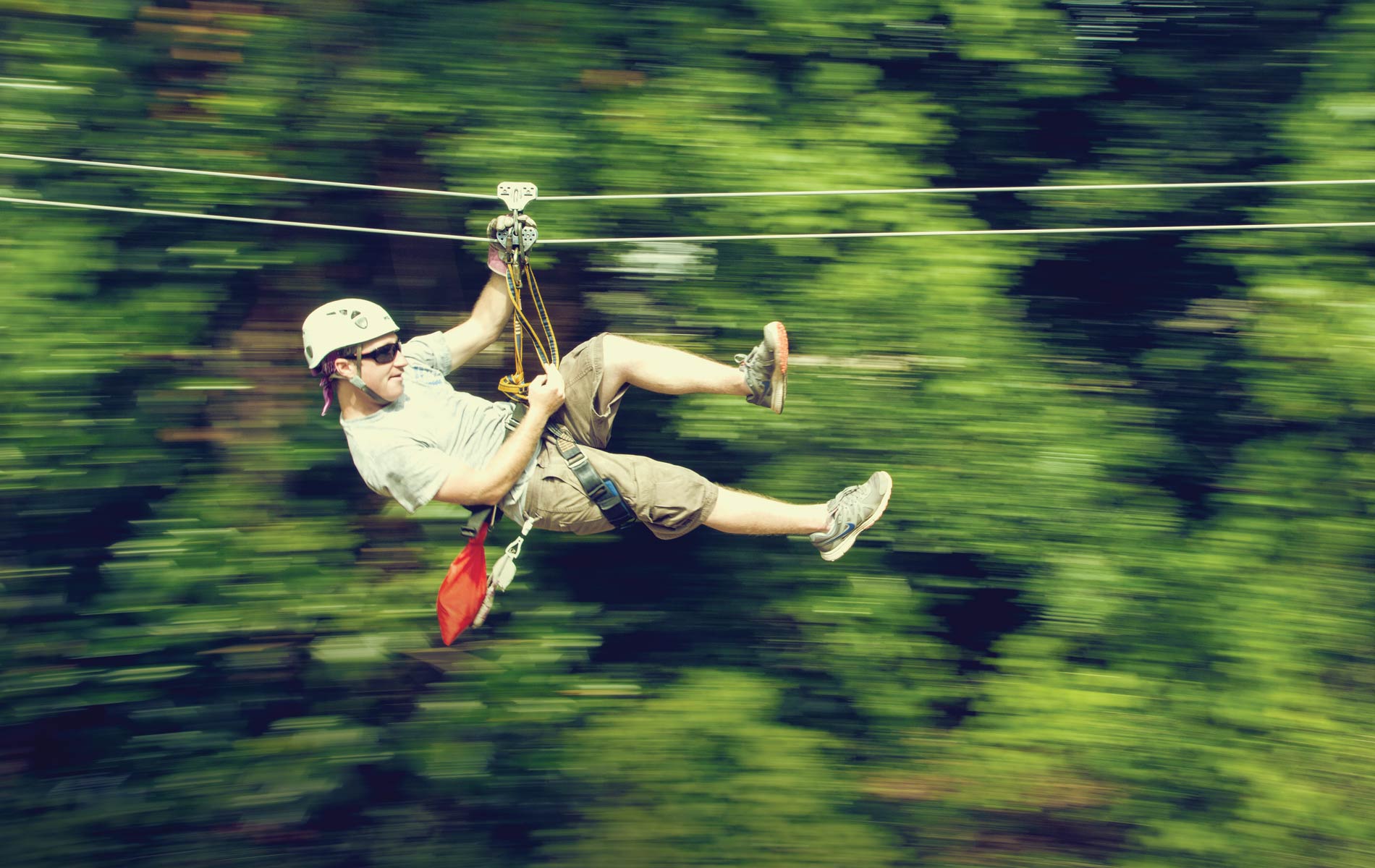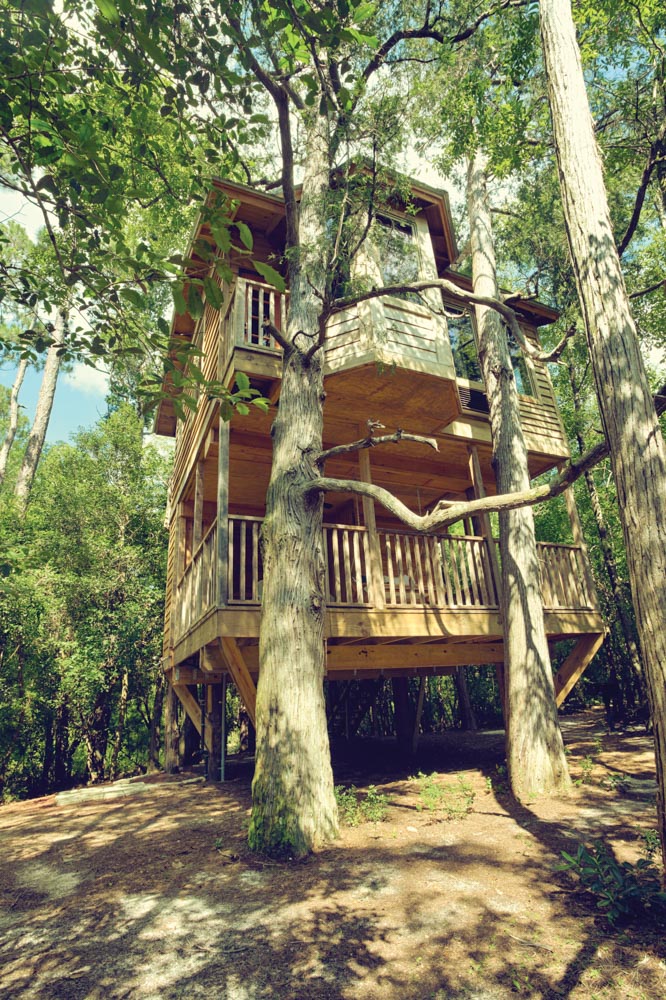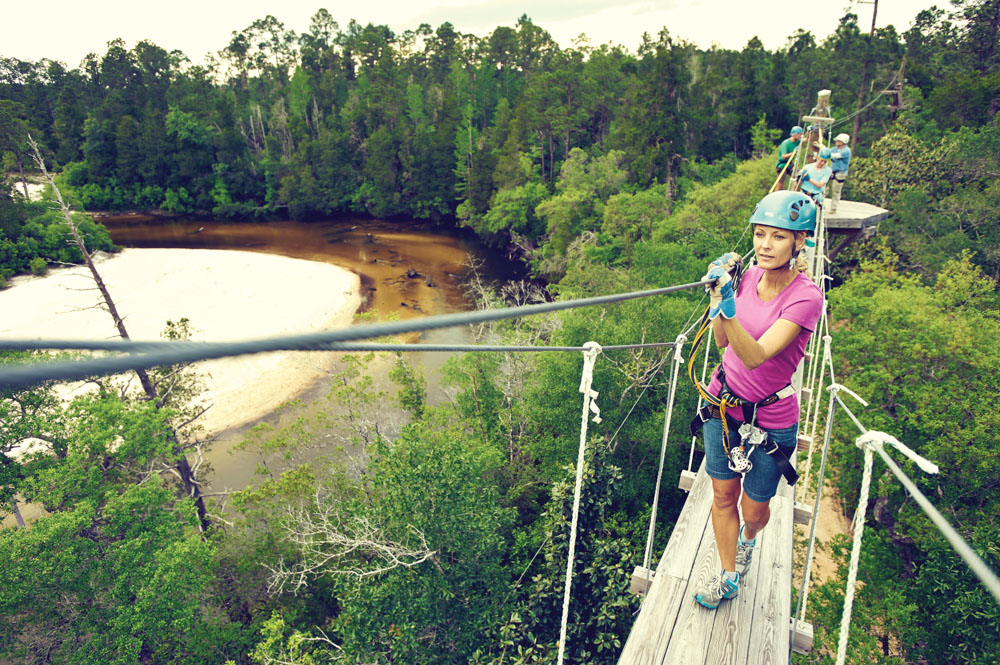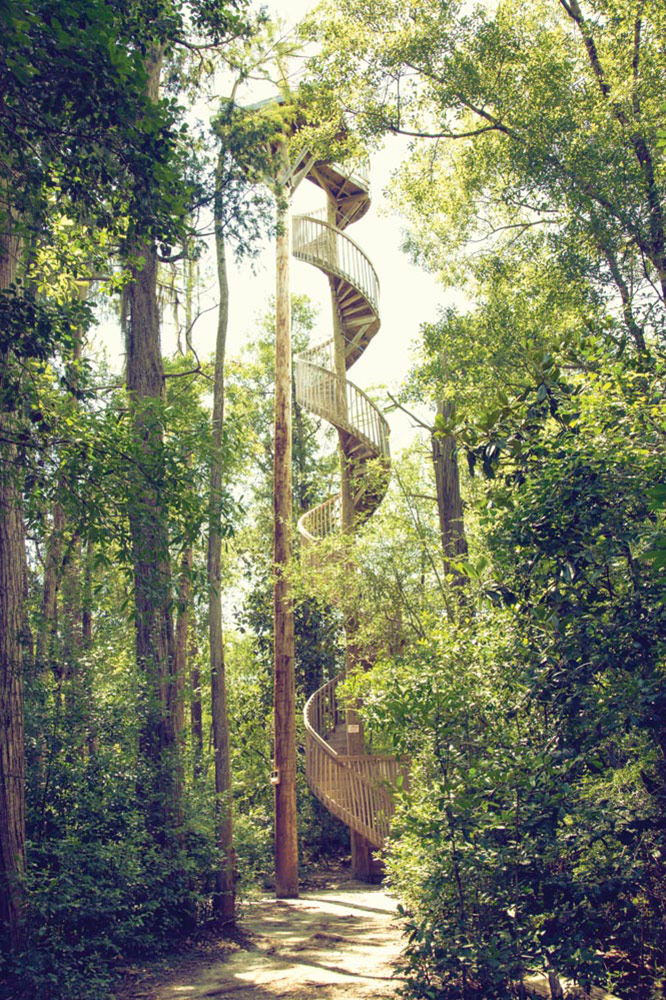
vie-magazine-adventures-unlimited-1
Call of the Wild
By Anne W. Schultz | Photography by David Moynahan
A yearning for outdoor adventure must be in our DNA. Why else would we scale Mount Everest, ski black-diamond slopes, raft treacherous white-water rapids, or bungee jump? “Adventure is something that has an uncertain outcome,” says Jack Sanborn, founder and owner of Adventures Unlimited, an outdoor adventure resort near Milton, Florida. His definition for adventure could also apply to life experiences. Perhaps the challenges of an outdoor adventure develop character traits like courage, resiliency, and endurance: just what we need for overcoming the difficulties life hurls our way. Or maybe it builds the self-confidence required to take risks, to venture out into new frontiers where we expand and grow. The best way to answer these questions for yourself is to do just that—jump in, take a risk, and find out.
Sanborn feels it makes life itself a more thrilling adventure as he still remembers the joy in exploring the wilds of North Central Florida around Gainesville as a young boy. “I grew up around nature. My uncle and grandfather built the first nature trail at Alexander Springs in Ocala Forest,” he says. “Our family spent free time hiking and camping.” He recalls the freedom of playing outdoors all day without adult supervision. “We made up our own games and rules. Friends and I explored creeks and woods on our own, encountering all kinds of wild creatures like alligators and snakes. Parents didn’t expect to see their kids home until dinnertime.
Here we not only build memories,
but also create future environmentalists.
“Today’s children don’t have that same kind of freedom, with their tightly structured and overly supervised schedules. They spend free time mostly indoors glued to computers and other electronic devices. Children are mainly spectators of adventure, experiencing it vicariously by staring at video games or action-packed TV programs or movies. I’d like to see kids participate in the real thing, where the heart starts thumping, adrenaline surges, and you feel an endorphin rush. It’s a thrill you never forget.”
So, when Sanborn retired as a helicopter instructor at Whiting Field near Milton, it became his mission to get kids and adults outdoors. “During active duty, I’d been looking for something for retirement where I could work outdoors, work with people, and be my own boss,” he explains. “Creating an outdoor adventure center satisfied all those needs and helped people get back into the wilds again. Its unlikely adults will head out for outdoor adventures if they didn’t experience those activities as a child. Here we not only build memories, but also create future environmentalists.”
Sanborn didn’t want anything resembling an amusement park ride. “When you go on an amusement ride at Disney, millions have gone before you and everyone knows exactly what to expect. But paddle a kayak down a wild river or fly free as a bird on a zip line over treetops and you have no idea what to expect,” he exclaims. He couldn’t have been stationed near a more advantageous site for an outdoor center than the dense forest and meandering creeks he discovered bordering Blackwater River State Forest. The region is described by the Nature Conservancy as “one of the most biologically rich areas in the United States.” The forest hosts three hundred species of birds and 2,500 species of plants, for starters. It is part of the largest contiguous longleaf pine forest in the world, a type of forest that once blanketed the entire southeastern United States. Now only 3 percent remains.
He bought some property as a Marine flight student and later added more when he returned to the base as a helicopter instructor. Upon retirement he opened the resort for full operation in 1976. Today, this unique place attracts over 45,000 visitors a year from all over the United States and many foreign countries.
The way the various lodgings are discreetly tucked into eighty-eight forest acres at the confluence of Wolfe and Coldwater Creeks evokes more of a spiritual retreat than a resort, where privacy and peacefulness abound. Everything—the rustic cabins and cottages; the elegant rooms of the School House Inn; and the latest addition, the Lorax Loft, a modernistic tree house of glass and reclaimed wood perched above the stream—blends seamlessly into the forest to highlight nature as the shining star. “We are completely unplugged,” says Sanborn with pride. “No telephones, no TVs, no clocks or radios. There is nothing to connect with except yourself and others while relaxing in rocking chairs, hammocks, and porch swings.
“Here people actually talk to each other face to face,” he laughs. “On many family vacations, people go their separate ways. Dads play golf. Moms shop. Not much interaction goes on. But here they are all brought together in one activity in one place. They all work together paddling down the river, and if the canoe turns over, everyone pitches in to right it. These shared experiences are topics of family conversations for many years to come.”
These shared experiences are topics of family
conversations for many years to come.
With the Blackwater River and its tributaries of Coldwater, Sweetwater, and Juniper Creeks offering so many miles of canoe trails, along with the resort’s extensive services, Sanborn coined the nickname “Canoe Capital of Florida” to describe it. And he initiated the process with state legislators to make the title official. Paddle down Coldwater Creek on a sunny fall day when you have the river all to yourself and you’ll see why. Sunshine glints on water colored golden amber from the tannins leached from decomposed vegetation. The water sparkles like a topaz jewel as it travels over a white-sand bottom mostly free of vegetation. Only a few feet deep, the water is exceptionally clean and clear because the Conecuh National Forest north of the river in Alabama means no development or agricultural activities interfere with the water’s purity. Coldwater is swift and narrow enough, and has enough obstructions like cypress knees and fallen logs, that navigating it keeps you challenged and alert. Even so, it’s still easy and fun for all levels to traverse. Wide sandbars tempt paddlers to pull over for a picnic lunch, take a break, or cool off with a refreshing swim.
The resort provides a fleet of two hundred fifty canoes, a hundred kayaks, five hundred tubes, and ten stand-up paddleboards to ensure everyone gets on the water during the peak summer season.
Visitors from sixty-eight countries have gone on the Zip Adventures Canopy Tour since it opened in 2010. They zoom over treetops and above Coldwater Creek on a mile of zip lines forty feet in the air spread over fifteen platforms for an unbeatable aerial thrill. The resort’s high and low rope challenge course is one of the finest in the southeastern United States.
In case you’re tired of floating or flying sky-high, come down to earth and stretch your legs on one of the hikes around the region. A three-mile interpretive nature trail winds along Wolfe Creek right on the property. Or if you wish to explore further, pick up directions and a map for major area trails at the office. These include the Juniper Creek Trail (a segment of the Florida National Scenic Trail), the Jackson Red Ground Trail (a twenty-one-mile forest trail tracing an early trade route used by Native Americans and settlers), and the Sweetwater Trail, which originates at either Krul Lake or Bear Lake.
Several years ago, Sanborn read an enlightening book that validates the importance of his work that brings people, especially children, back into nature. Recipient of the 2008 Audubon Medal and expert child advocate Richard Louv wrote the book Last Child in the Woods about children’s disconnection from nature. That disconnect results in what he calls “nature deficit disorder,” which is linked to rising trends of obesity, attention disorders, and depression. A video on the book’s website reminds us that children have played outdoors since prehistory; this is the first generation that spends more time indoors than out. It’s the first book to report the new and alarming research that “confirms a direct exposure to nature is essential for the physical and emotional health of children and adults.”
Those who already love being outdoors will savor more opportunities at Adventures Unlimited, while those who are estranged will soon feel right at home again. After all, nature is our home. It’s the beautiful earth God created for all living creatures to share. Renewing that ancient bond with earth restores joy and a sense of wonder in children. In his book, Louv writes often about wonder “the source of spirituality.” Sanborn reassures us that once children get out on the river, they absolutely love it. “And later on, they want to protect it,” he adds. “As it seems you only protect what you love.”
This affinity for nature appears to be an instinctual part of us, as Louv asserts, “We are genetically wired to be in nature.” Prominent American scientist E.O. Wilson coined the word biophilia to express the innate love of life he believes is implanted in all people. Thanks to people like Sanborn, Wilson, and Louv—along with a growing international movement to get people outdoors—the future looks brighter for children and also for nature, as it will be in the hands of those who have been touched by a wild river or shady forest. Could it be that God placed an innate love of life and a need for nature in our hearts so we not only value and preserve it, but also allow it to thrive and flourish?
— V —
Visit www.adventuresunlimited.com or call (850) 623-6197 for reservations or
more information about Adventures Unlimited.
Visit www.richardlouv.com to learn more about his book Last Child in the Woods.
Share This Story!
KEEP UP WITH THE LATEST STORIES FROM VIE
























































































































































